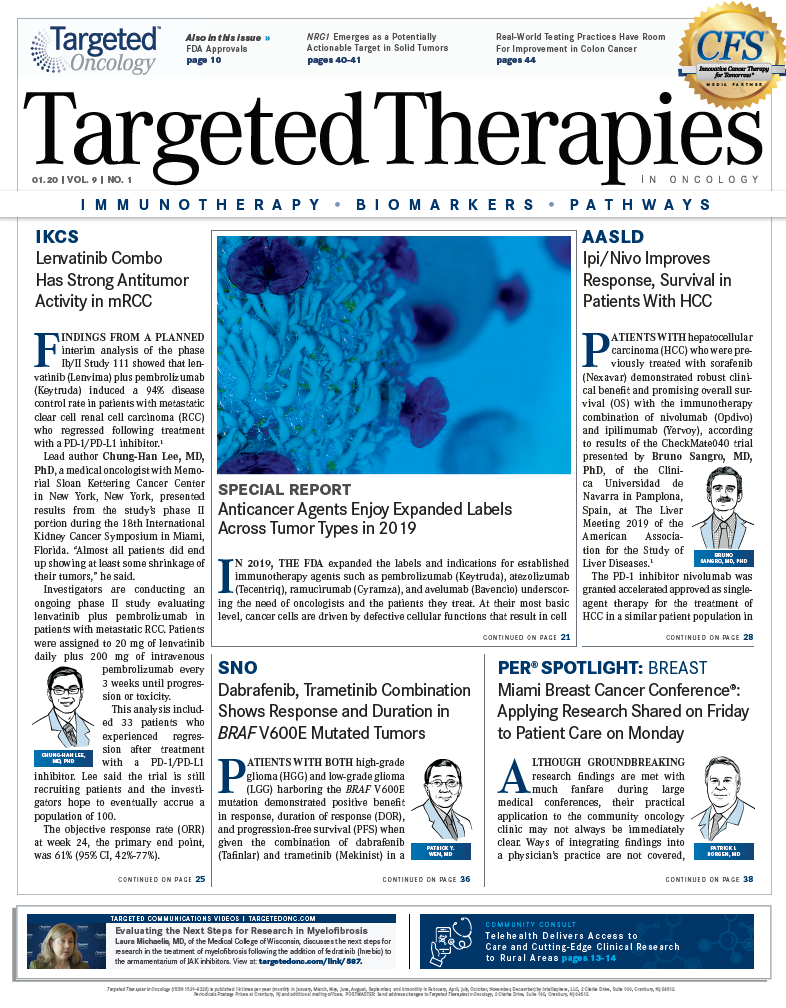Encouraging Results in First-Line Setting for HCC Usher Lenvatinib Toward Randomized Controlled Trials
The standard of care for some patients with intermediate-stage hepa­tocellular carcinoma may include lenvatinib if investigators further explore results from a proof-of-concept obser­vational study. The recommended treatment for intermediate-stage hepatocellular carcinoma, transarterial chemo­embolization, is unsuitable in patients with high-tumor-burden hepatocellular carcinoma, leaving a signif­icant unmet need in clinical practice for this patient subgroup.

The standard ofcare for some patients with intermediate-stage hepa­tocellular carcinoma (HCC) may include lenvatinib (Lenvima) if investigators further explore results from a proof-of-concept obser­vational study. The recommended treatment for intermediate-stage HCC, transarterial chemo­embolization (TACE), is unsuitable in patients with high-tumor-burden HCC, leaving a signif­icant unmet need in clinical practice for this patient subgroup.
Historically, lenvatinib has demonstrated sig­nificantly and clinically meaningful anticancer efficacy by reducing tumor size or enhancement on dynamic CT in a large proportion of patients (objective response rate [ORR], 61.3%) with inter­mediate-stage HCC.1,2 Intermediate-stage HCC is defined as Barcelona Clinic Liver Cancer stage B. Masatoshi Kudo and colleagues hypothesized that patients with the B2 substage might have better outcomes if initially treated with lenvatinib com­pared with TACE. The high tumor burden causes these patients to exceed the “up-to-7” rule, in which 7 is the maximum sum (in cm) of the size of the largest tumor and the number of tumors. The group presented their findings at The Liver Meeting 2019 of the American Association for the Study of Liver Diseases, held November 8 to 12, 2019, in Boston, Massachusetts.3,4
The investigators selected study participants from the 642 patients with intermediate-stage HCC who had received first-line treatment with lenvatinib or TACE from 2006 to 2018. After those who had Child-Pugh B or C liver function or were within the up-to-7 rule were excluded, 30 patients treated with lenvatinib were eligible for the study. Almost half had been enrolled in the phase III REFLECT trial, and the rest were treated with lenvatinib in the real-world setting.5
Using 1:2 propensity score matching, the 30 patients in the lenvatinib arm were matched with 60 patients treated with TACE in the front­line setting who were also Child-Pugh class A and whose tumor burden placed them out­side the up-to-7 rule. All patients were eval­uated for liver function deterioration, ORR, progression-free survival (PFS), and overall survival (OS).
Kudo reported that the ORR was 73.3% in the lenvatinib arm and 33.3% in the TACE arm, with an OR of 5.39 (95% CI, 1.90-16.67;P<.001). The clinical benefit rate, comprising complete responses (CRs), partial responses, and stable disease at ≥24 weeks, was 96.7% and 36.7% for the lenvatinib and TACE arms, respectively (OR, 48.1; 95% CI, 7.01-2073.85;P<.001). The disease control rate was reported as 100% and 55%, respectively.
The median PFS was 16.0 months (95% CI, 10.9-16.6) in the lenvatinib arm and 3.0 months (95% CI, 2.1-4.3) in the TACE arm, with an HR of 0.19 (95% CI, 0.10-0.35;P<.001). The median OS was 37.9 months (95% CI, 23.1-not reached) in the lenvatinib arm and 21.3 months (95% CI, 15.7-28.4) in the TACE arm, with an HR of 0.48 (95% CI, 0.16-0.79;P<.01).
To assess liver function deterioration, albu­min-bilirubin (ALBI) scores were compared between baseline and end of treatment, with a higher score indicating worse liver function. For patients treated with lenvatinib, the score rose slightly during the treatment period but returned to the baseline level by the end of treatment. In contrast, the ALBI score in the TACE arm increased significantly over the course of treatment (P<.01), becoming signifi­cantly higher compared with the lenvatinib arm (P<.05 at 3 months andP<.01 at end of treat­ment). Most importantly, the TACE arm’s ALBI score at the end of treatment not only failed to recover to the baseline value but also exhibit­ed the highest tested value. The investigators suggested a reason: The liver injury caused by TACE was irreversible (TABLE).
Kudo et al reported that the median duration of lenvatinib treatment was 13.1 months compared with 5.7 months in REFLECT.3 Additionally, the median time to first dose reduction was 13.1 weeks compared with 9.9 weeks in REFLECT.5,6
At the liver meeting, Kudo highlighted the case of a 70-year-old man who was negative for markers of both hepatitis virus B and C infection. The patient was also Child-Pugh class A and ALBI grade 1, indicating good liver function and a positive prognosis. However, he had 10-cm multinodular confluent-type HCC, which is associated with a poor prognosis and resistance to TACE. The patient had received 4 mg of lenvatinib daily from September 2014 through September 2018, at which time recur­rence was observed and TACE with cisplatin and lipiodol was performed. He achieved a CR and has been drug free for more than 14 months, Kudo reported.
Based on the demonstrated superiority of len­vatinib in terms of ALBI score, ORR, PFS, and OS, Kudo and colleagues concluded that this agent was more effective than TACE in the first-line setting. Further, they attributed lenvatinib’s favorable efficacy to its ability to cause tumor necrosis, tumor vessel normalization, and sup­pression of VEGF increase after TACE.
The investigators concluded that it would be worthwhile to conduct a randomized controlled trial to confirm the results of this proof-of-concept study and establish a new treatment standard for the subpopulation of patients with high-tumor-burden, intermediate-stage HCC.
References
- Kudo M. A new era of systemic therapy for hepatocellular carcinoma with regorafenib and lenvatinib.Liver Cancer. 2017;6(3):177-184. doi: 10.1159/000462153.
- Kudo M. Lenvatinib may drastically change the treatment landscape of hepatocellular carcinoma.Liver Cancer. 2018;7(1):1-19. doi: 10.1159/000487148.
- Kudo M, Ueshima K, Chan S, et al. Lenvatinib as an initial treatment in patients with intermediate-stage hepatocellular carcinoma beyond up-to-seven criteria and Child-Pugh A liver function: a multicenter propensity-score matched study. Presented at: The Liver Meeting of the American Association for the Study of Liver Diseases; November 8-12, 2019; Boston, MA.
- Mazzaferro V, Llovet JM, Miceli R, et al; Metroticket Investigator Study Group. Predicting survival after liver transplantation in patients with hepatocellular carcinoma beyond the Milan criteria: a retrospective, exploratory analysis.Lancet Oncol. 2009;10(1):35-43. doi: 10.1016/S1470-2045(08)70284-5.
- Kudo M, Finn RS, Qin S, et al. Lenvatinib versus sorafenib in first-line treatment of patients with unresectable hepatocellular carcinoma: a randomised phase 3 non-inferiority trial.Lancet. 2018;391(10126):1163-1173.doi: 10.1016/S0140-6736(18)30207-1.
- Yamashita T, Kudo M, Ikeda K, et al. REFLECT-a phase 3 trial comparing efficacy and safety of lenvatinib to sorafenib for the treatment of unresectable hepatocellular carcinoma: an analysis of Japanese subset [published online November 12, 2019].J Gastroenterol. doi: 10.1007/s00535-019-01642-1.

Survivorship Care Promotes Evidence-Based Approaches for Quality of Life and Beyond
March 21st 2025Frank J. Penedo, PhD, explains the challenges of survivorship care for patients with cancer and how he implements programs to support patients’ emotional, physical, and practical needs.
Read More